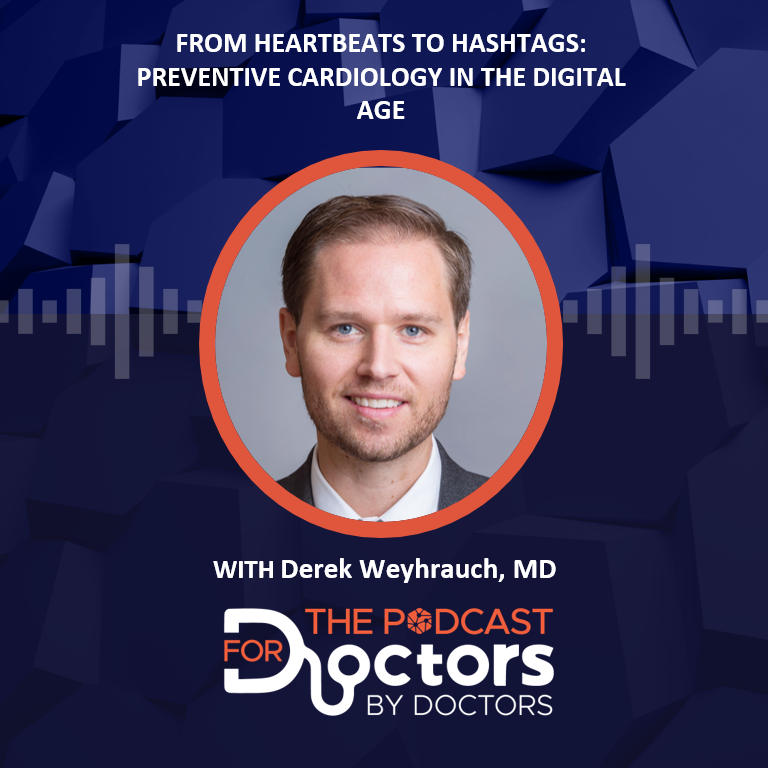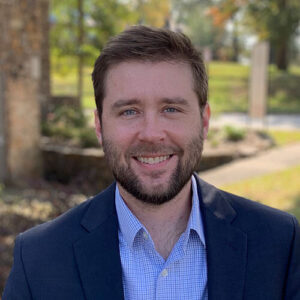Pediatric and preventive cardiologist, endurance athlete, and social media influencer Dr. Derek Weyhrauch joins Dr. Michael Jerkins to share how intense physical challenges, like swimming from Alcatraz and competing in Ironman triathlons, have shaped his approach to medicine, stress management, and patient care.
He details his journey from medical school to becoming a leading voice in preventive cardiology, emphasizing the power of lifestyle changes in combating heart disease. He opens up about the art of balancing a demanding professional life with personal passions, and why exercise and being outdoors are like an antidote for the stress of medical training.
How can a physician truly leverage social media to fight a rising tide of health misinformation? And what happens when the conversation shifts from generalized advice to candid talk about topics like cholesterol and vaccines? They dig into the opportunities and challenges of connecting with a broader audience, why human connection and storytelling remain irreplaceable in healthcare, and the enduring value of being a physician who educates through digital platforms.
Here are five takeaways from the conversation with Dr. Derek Weyhrauch:
1. Endurance Sports as Stress Relief
Dr. Derek Weyhrauch shares how his passion for endurance sports, like swimming from Alcatraz and competing in Ironman triathlons, serves as a vital outlet for managing the stress of medical training. He describes exercise as an “antidote” to the pressures of his profession, highlighting the importance of physical activity in maintaining mental health.
2. The Power of Social Media in Medicine
Dr. Weyhrauch discusses his unexpected journey into social media, initially encouraged by a mentor. He emphasizes the platform’s potential to educate and engage with a wider audience, combating misinformation and promoting preventive health measures. His approach is not about becoming an influencer but about being a physician who educates through authentic communication.
3. Combating Health Misinformation
Throughout the episode, Dr. Weyhrauch addresses the prevalence of misinformation, particularly around cholesterol and vaccines. He advocates for a firm yet engaging approach to educating patients, using personal anecdotes and evidence-based information to dispel myths and encourage informed health decisions.
4. Balancing Professional and Personal Life
Dr. Weyhrauch reflects on the challenges of balancing a demanding medical career with personal passions and family life. He shares insights into how he manages this balance, emphasizing the importance of setting goals and maintaining a supportive network to achieve both professional success and personal fulfillment.
5. The Value of Human Connection in Healthcare
The conversation underscores the irreplaceable value of human connection and storytelling in medicine. Dr. Weyhrauch and Dr. Jerkins discuss how authentic interactions and empathy can enhance patient care, bridging the gap between clinical expertise and compassionate communication.
Transcript
Dr. Derek Weyhrauch:
So with raw milk, I’ll say—do you eat raw meat? Like, do you eat raw pork or raw steak? If you equate raw milk to raw meat, okay, now I understand—that’s why it’s bad.
Dr. Michael Jerkins:
Welcome back to another episode of The Podcast for Doctors (By Doctors). I’m Dr. Michael Jerkins, riding solo again without the one and only Dr. Ned Palmer, who’s somewhere doing something fun in California—supposedly. I’m not sure if that’s true or not. Never know with that Dr. Palmer.
But what I can tell you for sure is that today we have a fascinating conversation with a cardiologist who’s very well-versed in social media, communicating with patients, and preventive cardiology and medicine. Preventive medicine is such an important topic these days—and has been, and should have been, for quite some time.
We’ll dive into all sorts of topics you’ve been hearing about, and I’m excited to pick his brain. So let’s hop right into our interview.
Today on The Podcast for Doctors (By Doctors) we’re joined by Dr. Derek Weyhrauch, a pediatric and preventive cardiologist who shares a message about heart attack prevention on social media. Originally from south of Seattle, where he completed medical school at the University of Washington, he then completed his residency at the Mayo Clinic and fellowship in Utah, where he began his preventive cardiology training and completed a postdoctoral fellowship with the AHA.
An enthusiastic triathlete and endurance athlete, Dr. Weyhrauch has swum from Alcatraz to the mainland not once, but twice—which I can’t wait to ask him about. He’s also raced the Leadville 100 mountain bike race in Colorado and completed several Ironman triathlons, with Ironman Chattanooga coming up right after this recording.
He’s most proud, however, of his role as a husband and father to two little boys—as well as finishing the ultramarathon that is medical training. He’s here today to tell us about that journey.
Dr. Weyhrauch, welcome to the podcast. I can’t resist starting with the obvious—tell us about your obsession with putting your body through all these endurance events, including swimming from Alcatraz.
DW:
Glad to be here—thanks for having me.
MJ:
So, swimming from Alcatraz to the mainland—explain that to us.
DW:
It’s funny timing with me having an Ironman this weekend—that’s a big part of my personality. You know the joke: “How do you tell there’s a triathlete at a party?” You don’t—they’ll tell you.
Like many things, triathlon and being a physician can both be all-consuming parts of your identity. I did my first Ironman in medical school two weeks before Step 1, which anyone who’s gone through medical training knows is the big test that your residency application hangs on.
I’ve always thought of exercise and being outdoors as an antidote to the stress of medical training—the bigger the dose of training stress, the bigger the dose of antidote.
The first time I swam from Alcatraz, it was thanks to my parents. My dad had a connection through his company with a sponsor role for the race. In Escape from Alcatraz, you go out to the island, jump off into the water from a ferry, and swim to the mainland. I think I was 17 when I did it for the first time.
MJ:
And then you did it again, right?
DW:
Yeah, just last year. That’s the challenge I really enjoy. I’ve found it rewarding through my social media to get messages from pre-meds, med students, and people who have loved ones in medical training saying, “Thank you for showing that you can be a happy doctor.”
Last year when I did Escape from Alcatraz again, it was cool to go back over 20 years later and jump into the same water—it was a little colder this time. What’s wild is that 24 hours later, I was across the country driving into a rural pediatric and preventive cardiology clinic. There’s some time compression as a physician, but you can still fit in life experiences that enrich everything.
MJ:
That’s the tough part—balancing it all, especially with family and medical training. Kudos to you for managing that. Can you walk us through why you wound up in preventive and pediatric cardiology? Why this path?
DW:
Thanks. It’s interesting—when you look at specialty selection, physicians only stay in the specialty they originally intended about 25% of the time. I didn’t have preventive or pediatric cardiology on my radar going into med school.
During third-year clerkships, I found I really liked surgical fields—three or four of my top five favorite rotations were surgical. But I ended up drawn to cardiology—the combination of a specific, fixable problem and the intellectual challenge, plus the excitement of working with the heart.
Then, during my pediatrics rotation, I realized how rewarding that patient population was. Everyone finds that connection differently—ER docs with crisis patients, internists with geriatrics. For me, it was pediatrics.
Later, in pediatric cardiology training, I found the field was very research-focused. I pursued that and began funded investigation into the genomics and bioinformatics of congenital heart disease. But I also discovered that my passion for endurance sports—the thing that helped me handle the stress of medicine—aligned really well with preventive cardiology.
There’s an art and science to advanced lipid management, but also a coach-athlete relationship when working with patients on nutrition and fitness. It was a natural evolution of my personal interests and mentorship.
MJ:
Then you started bringing that message to social media. Was that planned, or did it just happen?
DW:
A bit serendipitous, honestly. My personal style in research and leadership meetings is pretty consistent with how I am online.
As a cardiologist, you’re part of a heart center—working closely with pediatrics, ICU, and cardiothoracic surgery. During my annual faculty evaluation, our head executive cardiologist, Dr. Andrew Reddington, who’s internationally renowned, told me, “You should do social media.”
I hadn’t thought of that before. He said I had a style and approach people might engage with. So, I made an account, but only posted occasionally—at conferences or a couple times a year.
About a year ago, I had around 100 followers and decided to take it more seriously: post almost every day for a year and aim for 1,000 followers by the end. Maybe 10,000 after two years.
It grew much faster than expected—faster than I even wanted at times—because my goal wasn’t to be an influencer, but a physician educating through social media. I’m not a content creator; I’m just a doctor making videos. But that’s happily led to connecting with you and the team, and to some really great experiences this past year.
MJ:
That’s awesome. Let me ask you this—speaking of social media and where we are in society health-wise today, a lot of news and tips get thrown around. Is there a health tip you’ve seen go viral online that you wish would disappear forever?
DW:
Yeah, every time I go online, I’m reminded why I post on social media. Every single week, I meet a new family who has had someone die or experience a serious heart attack or stroke that was completely preventable in their 30s, 40s, or 50s. That’s my primary motivator.
But as a user, I also see misinformation constantly. Some of the worst stories I’ve seen involve children harmed through unsafe practices, often linked to vaccine hesitancy or anti-vaccine sentiment. If I had to pick one thing that really frustrates me, it would be anti-vaccine misinformation.
Interestingly, I also see a lot of conspiratorial thinking about cholesterol and statins. For example, last week I had a young woman in clinic with her mom. The mom had just been advised to take a statin but was worried about a supposed link with dementia—which is completely unfounded.
DW:
So I explained it like this: there’s no link between statins and dementia. In fact, statins protect against vascular dementia by supporting blood flow to the brain. Many people spreading misinformation about cholesterol don’t realize that the brain makes its own cholesterol behind the blood-brain barrier. The cells can produce and export what they need.
So lowering cholesterol in the blood only reduces what circulates outside the brain. I explained that the statins actually prevent heart attacks or strokes, which means you live long enough to potentially develop dementia—but that’s not because of the statins. The daughter burst out laughing and said, “Thank you so much, you just completely put that to use.”
DW:
I try to take a firm, fair, and fun approach to misinformation. You can teach people so they’re better protected against falsehoods, while still addressing their concerns instead of dismissing them. So, for me, anti-vaccine beliefs and cholesterol myths are the big ones.
MJ:
I love that approach. I had a similar conversation yesterday with a patient about cholesterol—though it was a slightly different spin. Some people argue we actually need higher cholesterol to prevent heart attacks. There’s a YouTube cardiologist with videos on that topic. Everyone’s trying to understand what’s best for their health, so having patience and a conversation is key. It reminded me of reading about FDR’s physician, who believed higher blood pressure was necessary to push blood through aging vasculature—though FDR ultimately died of a stroke.
DW:
Yeah, there are basically two popular misinformation philosophies about cholesterol. Some people cherry-pick studies showing worse outcomes with low cholesterol—but often, these are cases where patients already had plaque buildup or prior strokes. Low cholesterol in that context isn’t the problem; it’s too late.
I usually take 30+ minute visits just to educate patients on how cholesterol builds up, like snow accumulating over time. Once they understand the process, they see why low cholesterol isn’t inherently bad, and why high cholesterol still needs management.
There are even studies, like the Keto CTA trial, that went viral because some believed high LDL wasn’t harmful in lean, active individuals with low triglycerides and high HDL. The trial had to hide initial findings because plaque accumulated much faster than expected in just one year. Personal anecdotes help too—families relate to real stories more than guidelines or professional opinions.
DW:
I often tell patients: I don’t see drug reps, I don’t take money from pharma, I read studies carefully. I explain what I would do for myself or my own child. That honesty resonates—the guidance is exactly what I’d give to my little boys.
MJ:
It’s fascinating how human-to-human interaction carries so much value. Even with AI or encyclopedic knowledge available, real-world experience and candid conversations make the difference.
DW:
Exactly. On social media, there are many who claim credentials without truly having them. Experience matters. I often explain to families: have they seen a heart attack in real life? Have they worked nights in the ICU? Our crucible of medical training validates our perspective. Beyond that, I ask patients for their treatment preferences, then share what I’d do for myself or my family. That transparency builds trust and catharsis.
MJ:
I would never recommend something to you that I wouldn’t do for my own family in the same situation. And I do mean that. There are times when I’m like, I’m actually not sure—let’s talk about what I would do and the things I would consider.
I think it’s easier to understand this: the less you know about something, the more confident you are in it. Anyone not in healthcare can easily talk about AI replacing doctors. Rarely do I see doctors discussing it.
When non-doctors talk about AI replacing physicians, it’s usually people who have never treated a patient. They don’t understand all the things that actually happen. Healthcare isn’t just handed objective data—you can’t just hand a sheet back with a treatment plan and move on. That’s not how care is delivered, and it’s all the in-between that our robots currently can’t—and arguably shouldn’t—do.
DW:
I should do a post about it—like in 1900, books were supposed to replace doctors. Then the internet in the 1980s and 1990s, “We won’t need doctors anymore.” Now it’s AI: “We won’t need doctors.” I think an AI-empowered physician can really help. I love these two lines: AI won’t replace doctors, but doctors who use AI will likely surpass those who don’t.
We also have so many barriers to improving our healthcare system. If we used AI safety systems, administrative systems, billing systems…there’s this chart I’ll share in a post showing physician growth over time. Flat physician growth versus administrative growth is like Mount Everest next to a flat road.
DW:
I think we could positively impact healthcare through AI making systems more efficient. That gives physicians and clinicians more time at the bedside.
MJ:
Speaking of technology, what are your thoughts on wearables? Are there any devices you think have merit for wider population use?
DW:
I had a positive experience when ECG-enabled smartwatches first came out. Early on, there was a lot of concern about atrial fibrillation in people with zero risk factors—it was mostly artifact misdiagnosed by the device. As the technology improved, it became something like 20 false alarms out of 20, with maybe one true positive.
Patients could catch short runs of supraventricular tachycardia (SVT) or other arrhythmias that truly impact their health. Sending someone home with a Holter might not catch a problem in three to seven days, but a mobile device lets them spot-check their own heart rhythm, which can be very useful.
So I wouldn’t call it mainstream, but it’s a positive adjunct for heart evaluation. For me, it’s also about how you use the data. Smart tech that improves sleep quality, for instance, is fantastic. Families ask about nutrition and fitness, and I start each counseling session talking about sleep and stress.
DW:
If a smartwatch helps someone sleep better, that’s amazing. If it just provides more low-quality data that distracts from basics, we don’t use it. It’s definitely a tool, but it doesn’t replace what we know works.
MJ:
It sounds like you get a lot of time for patient counseling—which is great. I heard you say 30 minutes. I haven’t had 30 scheduled minutes in ages! In those sessions, do patients ask a lot about seed oils and raw milk? How do you respond if they think they should incorporate—or avoid—those?
DW:
I’m happy to say that hasn’t come up often in my clinical practice, though it’s everywhere on social media. Both are similar to cholesterol misinformation: you want to understand the problem, then respond thoughtfully.
With raw milk, I tell families I’ve cared for children hospitalized with hemolytic uremic syndrome. I explain the cause, prevention, and why it’s risky. There’s no nutritional benefit to skipping pasteurization. I often use analogies—if you equate raw milk to raw meat, it clicks: “Oh, now I understand. That’s why it’s bad.” You wouldn’t eat roadkill, right? Analogies help connect concepts to things they know are dangerous.
DW:
For seed oils, I share well-studied information and resources. There’s a fantastic YouTube channel by an MD/PhD physician, Dr. Gil Carvalho, that I reference. It’s completely data-driven and objective, going through dozens of studies. I tell families, “I only want what’s best for your child.”
I explain that evidence shows seed oils are generally benign—it’s not that they’re good or bad, but neutral. Avoiding them isn’t harmful unless replaced with alternatives we know are bad. At home, we mostly use olive oil, sometimes butter, occasionally other seed oils.
I even use humor to help families understand. For example, I might say: if your health and finances are so dialed in that your biggest concern is seed oils, you’ve basically won—you’re so locked in. By educating families, giving resources, and offering an informed opinion, you help them focus on what really matters instead of wasting time.
MJ:
What’s the YouTube channel?
DW:
It’s Nutrition Made Simple by Dr. Gil Carvalho. I love how data-driven he is—he cites studies and is candid. I tell families not to follow someone locked into one extreme diet perspective. There’s no single nutrition approach for everyone. What works for one person might not work for another, depending on family, culture, and health stage. Hyper-exclusive diets aren’t usually the best long-term.
He presents nuance: someone can follow a low-carb diet in a healthy way, like salmon on mixed greens, or in an unhealthy way, like just salami and cheese. I appreciate a balanced, evidence-based voice—it’s a beacon in the wilderness of online nutrition content.
MJ:
What do you think about buying supplements off TikTok Shop?
DW:
That’s a fantastic question. It’s been interesting—surprising even—to receive messages from potential channel partners asking me to endorse or recommend supplements. I’ve been offered surprisingly lucrative deals by supplement companies, and I’ve universally declined.
If someone asks me about supplements, here’s my analogy: one triathlete once said, “Speed work is the frosting, and you don’t have the cake yet.” Focus on the essentials first: Are you sleeping 7–8 hours a night, well-rested without naps? Are you proactively managing stress? Eating a whole-foods-based, calorie-conscious diet? Exercising daily?
If all of those are consistent, adding supplements like creatine, magnesium, or melatonin might slightly empower your health. But if you aren’t addressing the basics, supplements aren’t even the frosting—they’re just the sprinkles on top of frosting. Many people focus on supplements seeking a quick fix, but without proper sleep, stress management, exercise, and nutrition, supplements do very little. In my practice, I’d love to talk about them, but I have to cover the essentials first.
MJ:
Never get to the sprinkles. That makes total sense. Thinking about diets when I was a kid, food was fairly standard. Do you think kids today have healthier hearts than those in the 80s and 90s?
DW:
No, much more unhealthy. Right now, in preventive cardiology referrals, we’re seeing a lot of metabolic liver disease, insulin resistance, high triglycerides, and cholesterol. American culture trends toward more sedentary activity, climate can play a role, and local food culture matters—fast food predominance, higher-calorie foods, or cultural specialties.
Overall, I worry that children’s heart health is worsening, and we’re going to see heart attacks in people in their 30s within the next couple of decades.
DW:
For example, my son, in elementary school, asked for toast for breakfast. I make his breakfast each school day. I picked a high-quality whole-grain bread with nuts and seeds. But when I checked the label, each slice had four grams of sugar—the equivalent of sprinkling a crumbled Oreo on top of bread. This company may have been health-focused, but they were bought by a food conglomerate in 2017.
I looked at 10 other “health” breads—same issue with added sugar. Families often aren’t intentionally eating poorly, but hidden sugars add up. A soda can equal two slices of cake. Three sodas a week? That’s like cake every day.
I once had a family confused why their child’s triglycerides were high. They said, “We don’t eat that much sugar.” Dinner was a pork chop with vegetables and mashed potatoes. The hidden culprit? Barbecue sauce—two Oreos worth of sugar per tablespoon. It’s not intentional; it’s hidden.
Unless we hold companies accountable for ultra-processed foods, we’re all swimming in bad water. Even families trying to eat healthy are affected by high-calorie, hyper-palatable foods everywhere.
MJ:
What’s the one health policy change we could enact today to have the biggest impact on children’s heart health?
DW:
No added sugar. Based on thousands of patient encounters, if I had to choose one thing for a teenager, I’d say: no liquid sugars immediately. Even families eating mostly whole foods still have treats—strawberry-coated pretzels, for example. Kids’ palates get corrupted by hyper-processed, calorie-dense foods. Vegetables taste like grass to them. Combatting the ultra-processed environment, starting with added sugar, and encouraging physical activity would be my top two interventions.
MJ:
If you had unlimited research funding, what would you study?
DW:
I’m obsessed with energy balance. In working with thousands of families, when it’s successful, there’s always a paradigm shift—they eat healthier, stop eating poorly, and become more active. I’d love to study how to reliably achieve this.
I’d give families access to tools—walking pads or treadmills set for 30 minutes at 3% incline, three miles per hour daily, plus wireless headphones to make it feasible. The goal would be capturing energy balance, similar to the Ironman Hawaii course’s “energy lab,” to help families achieve sustainable activity and healthier diets.
MJ:
I think you’re maybe the second or third ultra athlete—well, endurance athlete—I don’t even know the right terms; that shows how little of an ultra athlete I am—on this podcast. It’s weird that both you and Dr. Martin are pediatricians.
DW:
Was that Dr. Tommy Mar—
MJ:
Yeah, Tommy Martin. Do you think pediatrics has the highest percentage of endurance athletes of any specialty? I’d think emergency medicine.
DW:
I’m really good friends with several emergency doctors; they mountain bike and rock climb—they’re always down for a good time. Maybe it’s the personalities drawn to pediatrics, or the challenge and rewarding nature of the work. With Dr. Martin, I connected with him through social media, just like I did with you. I’ll be supporting his Cape Epic challenge. It’s funny: a year ago I had 100 followers on my account, now Dr. Martin is following me, and messaging back and forth. We’re basically best friends who’ve never met in real life.
DW:
I messaged him about doing an Ironman and joked (with permission) that I’d post about it. He had recently completed a half Ironman in partnership with the Ironman Foundation. I thought, I’m a competitive triathlete for my age, let’s see how he does—and he blows me out of the water. He’s so fast, so fit, and the nicest guy. I joke that if I were a Pokémon, the next level up would be Dr. Martin—super inspirational.
MJ:
I bet he uses more exclamation points in text than you.
DW:
Yes, definitely an addiction. I try to limit them, but he uses them aggressively—it’s authentic energy.
MJ:
Exactly, his speech comes through in text.
DW:
Alright, rapid fire statements—true or false, with your opinions.
MJ:
First: we’d be better off making medical school three years instead of four.
DW:
There’s a physician shortage, so condensing medical school seems appealing—fourth year is often more relaxed, non-essential clerkships. But the problem is residency and fellowship.
MJ:
Tell me why.
DW:
Look at training hours: a three-year Doctor of Physical Therapy program has about 120–130 credits. My MD had 320 credits in four years. If you compress medical school further, already-strained graduates enter residency with even more compressed schedules—it could be detrimental.
Instead, increase capacity: open funding for more residency slots, recruit quality international medical graduates. That prevents compressing training while maintaining the highest standard of medical education.
DW:
For me, the fourth year was transformative. Third-year clerkships, I was focused on high passes and honors. Fourth year gave me extra time and counseling, which prepared me for intern year. Compressing medical school would strain graduates unnecessarily. Increasing capacity is a better solution.
MJ:
Next: pediatric cardiology fellowship is harder than adult cardiology fellowship.
DW:
I’m good friends with Kendrick and others, and I’d say false—but pediatric training is often misunderstood as rigorous. Pediatric residency is harder than internal medicine residency.
DW:
Adult cardiology fellows see STEMIs, amyloidosis, HFrEF/HEF-REF, and repeat that cycle. Pediatric cardiology fellows: 36-hour shifts, admit failing Fontan, new diagnoses (e.g., Tetralogy of Fallot), heart transplant patients in rejection, post-op complications, ECMO cases—all in an eight-hour overnight window within a 36-hour shift. The rigor is brutal.
MJ:
Interesting. As a med-peds physician, I’m curious—where does med-peds fit in that spectrum?
DW:
Med-peds takes on both pediatrics and internal medicine simultaneously—definitely tough. Maybe you’re the triathlete of the group.
MJ:
Wow. Maybe we have the highest predilection of endurance athletes. Maybe I’m in the minority. That sounds like a good study someone should do.
Next true or false: doctors of previous generations worked harder than doctors today.
DW:
That could be it, but consider what I just described—an Epstein’s patient, failing Fontan, ECMO, heart transplant. Previous generations wouldn’t have had ECMO, heart transplants, complex echoes, caths, congenital surgery, or staged surgical palliation.
Even if they worked long hours, I still worked over 100-hour weeks for more than five weeks straight, on call every third or fourth night, sometimes 36-hour shifts. They thought they had it harder doing 120-hour weeks. I’d argue it’s harder to run all-out 100 miles than jog 120. Medicine is only getting more complex. Managing ECMO, heart transplants, and complex stage surgical palliations in a single shift? That’s more complex than it was before.
I’ll never be an attending who tells trainees they had it easier than I did. It’s more complex now, and trainees are more strained, even if their hours are slightly less.
MJ:
Fascinating. It’s more than just time spent in the hospital. Last true or false: LDL is the most important lab value to track for heart health.
DW:
False. It’s the most misunderstood lab. People often say, “LDL isn’t bad, it’s inflammation that’s bad.” That’s like telling an Australian great white sharks aren’t dangerous because a crocodile attacked someone.
Each factor—LDL, Lp(a), triglycerides, insulin resistance, blood pressure, HS-CRP/inflammation—can independently cause a heart attack, depending on exposure and severity. None is inherently the “worst.” Lp(a) can be worse, inflammation can be worse, but inflammation plus high LDL? That’s even worse. Misconceptions abound, but LDL gets the most attention.
MJ:
Last question we ask every guest: has there been anything you’ve recently changed your mind about?
DW:
Everyone has personal bias. I used to think gentle walking wasn’t enough to burn significant calories. But I recently had a patient on weight-loss medications. We started with lifestyle measures—resistance training, protein, diet, walking. Three months later, she lost 30 pounds. She walked one hour every day consistently.
What struck me was that my belief—more intense exercise is always better—was challenged. It’s about consistency and what the person can actually do. I now recommend walking all the time, tailored to the individual’s capabilities. My patients continue to prove me wrong, in the best way.
MJ:
Amazing. Dr. Wierach, where can people find more about you online?
DW:
I engage with people as much as possible. My main platform is Instagram: search Derek Wyrach, spelled W-Y-R-O-C-K, MD. Also on TikTok, Facebook, and YouTube, where I post long-format educational videos. Instagram and YouTube are the main places.
MJ:
Thank you for being here and for all the work you do with families, patients, and communities. Amazing work, we appreciate your time.
DW:
My privilege. Thank you so much for the opportunity.
MJ:
You can catch The Podcast for Doctors (By Doctors) on Apple, Spotify, YouTube, and all major platforms. If you enjoyed this episode, please rate and subscribe. Next time you see a doctor, maybe prescribe this podcast. See you next time.
Check it out on Spotify, Apple, Amazon Music, and iHeart.
Have guest or topic suggestions?
Send us an email at [email protected].

Feeling Disappointed On Match Day? What’s Next? – Match Day 2026
According to the NRMP 2024 Main Residency Match Results and Data, less than half of all Match Day applicants were matched with their first choice...

What To Do If I Didn’t Match: SOAP Tips & More
Every year, thousands of medical students apply and interview for residency. In 2025 alone, 47,208 applicants submitted a certified rank order list of their preferred...

What Happens If I Didn’t Match Into A Residency Program?
If after completing SOAP you are still unmatched, it is important to take a moment to rest. Though you will not be entering residency this...



